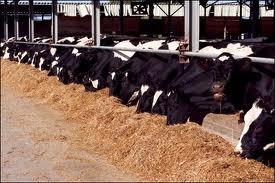AgroterrorismProtecting the U.S. food supply from agroterrorism
“For the life of me, I cannot understand why the terrorists have not attacked our food supply because it is so easy to do,” said Tommy Thompson during his 2004 farewell speech when he left his post as U.S. secretary of Health and Human Services. Documents found in a 2002 U.S. military raid on an al-Qaeda warehouse showed that terrorists sought to contaminate the U.S. food supplies. The documents included detailed instructions for attacking U.S. agricultural assets. Researchers at the University of California-Davis’ Western Institute for Food Safety and Security(WIFSS) are studying vulnerabilities of the U.S. agricultural system to the threats of agroterrorism.

Agroterrorism is relatively easy and inexpensive // Source: fbi.gov
Researchers at the University of California-Davis’ (UC-Davis) Western Institute for Food Safety and Security (WIFSS) are studying vulnerabilities of the U.S. agricultural system to the threats of agroterrorism.
Documents found in a 2002 U.S. military raid on an al-Qaeda warehouse showed that terrorists sought to contaminate the U.S. food supplies. The documents included detailed instructions for attacking U.S. agricultural assets.
WIFSS, founded in 2002 and funded in part by DHS and the Food and Drug Administration, has been a primary source for solving the country’s food-security issues. “We look at the potential ways in which crops or animals could be given some kind of disease agent that would create a major catastrophic event,” said Dr. Bennie Osburn, director of outreach and training, and Dean Emeritus for the School of Veterinary Medicine at UC-Davis. “There’s concern about botulism, for instance, getting in the food supply, or ricin.”
California’s Yolo county accounts for 90 percent of the canned and processed tomato production in the United States, and Sacramento is home to 1.5 million acres of farmland. The region’s agricultural assets make it an inviting target for agroterrorism, a subset of bioterrorism which targets crops and livestock as a medium for warfare by introducing dangerous pathogens and biological agents meant to disrupt economies and kill people. The United States experienced a form of domestic agroterrorism in 1984, when followers of cult leader Bhagwan Shree Rajneesh infected ten salad bars in Oregon with salmonella, leaving 750 people sick.
Osburn sees WIFSS as a model for preventing future disasters. It offers farmers, veterinarians, and public health officials DHS-certified courses on how to respond to agroterrorism events. “Homeland Security is looking at more than agroterrorism now,” he said. “They have us looking at all hazards that disrupts the food supply or causes contamination that leads to further problems. And then, how do we help these folks plan for that so there’s better coordination? We’re trying to sustain the food supply.”
Though a large-scale agroterror attack has yet to materialize, DHS and FDA officials remain concerned, citing the easy access to major crops and livestock systems in the United States. “For the life of me, I cannot understand why the terrorists have not attacked our food supply because it is so easy to do,” said Tommy Thompson during his 2004 farewell speech when he left his post as U.S. secretary of Health and Human Services.
Craig McNamara, a Yolo County walnut grower and president of the California State Board of Agriculture, believes the security of the U.S. agriculture sector can be credited to vigilant farmers and security measures put in place. “In California, we’re doing everything we can in agriculture to ensure we’re not susceptible,” he told the Sacramento Bee. “First and foremost, farmers are tremendously optimistic. Do potential threats exist? Certainly they do. But on the other hand, we’re on our land and monitoring is taking place.”
WIFSS operates a series of research farms where researchers can introduce controlled forms of salmonella and E. coli bacteria into the soil or crop’s irrigation systems to understand how far and quick the bacteria may spread in the field. For the 2006 E. coli outbreak which originated in a spinach crop in the Salinas Valley and caused three deaths and sickened 200 people, researchers at WIFSS found wild pigs to be the carriers of the bacteria.
